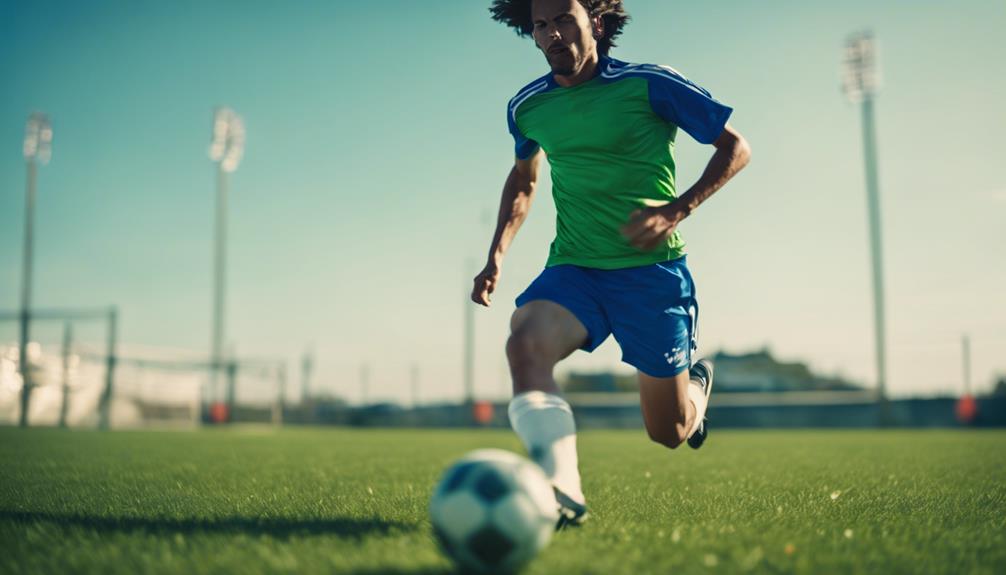
Top Cardio Workouts for Soccer Players
July 26, 2024Elevate your soccer game with top cardio workouts. Start with running to boost stamina and speed, perfect for covering game distances. Cycling is ideal for strengthening the legs essential for soccer moves. Immerse yourself in swimming for overall endurance without stressing the joints. High-Intensity Interval Training (HIIT) amps up your fitness levels for soccer demands. Cross-training provides an extra edge by enhancing both endurance and muscle strength. Cardio circuit workouts are a surefire way to improve on-field performance. Don't forget pre-game routines to warm up effectively. Ready to take your game to the next level?
Importance of Cardio for Soccer Players
To excel on the soccer field, you must understand the crucial importance of cardio training for maintaining peak performance. Soccer players rely heavily on their stamina to cover an average of more than five miles per game. This emphasizes the critical role cardiovascular endurance plays in sustaining high levels of energy throughout matches. Without adequate cardio training, players may struggle to keep up with the fast-paced demands of the game, leading to decreased performance on the field.
Stamina is a key factor in soccer, with players needing to sprint, jog, and maintain consistent movement throughout the game. Cardio workouts are essential for improving players' endurance levels, allowing them to withstand the physical demands of a match.
Running for Stamina and Speed
Enhance your soccer performance by incorporating running workouts focused on stamina and speed. Soccer demands endurance and speed, making running an essential component of your training regimen. Running helps build the endurance needed to cover the 5-7 miles average distance per game, ensuring you maintain peak performance throughout the match.
Incorporating sprinting intervals into your routine not only enhances speed but also improves explosiveness and anaerobic capacity. This type of training is vital for those quick bursts of energy needed during sprints or challenges on the field.
Additionally, shuttle runs and interval training can mimic game scenarios, helping you adapt to the stop-and-go nature of soccer while boosting your overall performance.
Consistent running routines, such as 30/60s for jogging simulation and sprint repetitions, are key for soccer conditioning. These workouts not only improve your cardiovascular fitness but also prepare your body for the physical demands of the game.
Cycling for Leg Strength

Strengthen your leg muscles important for soccer performance by incorporating cycling, a low-impact cardio workout. Cycling is a fantastic way to enhance your lower body strength and stamina, specifically targeting the leg muscles essential for peak soccer performance. This form of exercise not only improves your endurance but also helps in developing power and agility on the field.
Riding a bike regularly can complement your soccer conditioning routine by focusing on the specific muscle groups needed for quick sprints, jumps, and directional changes during gameplay. Additionally, cycling is gentle on your joints, reducing the risk of injury while still providing an effective cardiovascular workout.
Swimming for Endurance
You can enhance your endurance by incorporating swimming into your training regimen.
Swimming is a low-impact workout that targets multiple muscle groups, improving overall strength and stamina.
Varying your strokes can help intensify the workout and maximize its benefits for your soccer performance.
Water-Based Endurance Training
Swimming provides soccer players with a well-rounded water-based endurance training regimen, engaging multiple muscle groups to improve overall fitness levels. This form of endurance training is particularly beneficial for soccer players as it helps enhance cardiovascular endurance, breathing efficiency, and stamina, all essential for performing well during long matches. Additionally, swimming serves as a low-impact workout, reducing the risk of injuries while aiding in the recovery process. By incorporating swimming sessions into their training routine, players can also boost their lung capacity and improve oxygen utilization, leading to enhanced performance on the field.
Moreover, swimming offers the opportunity for interval training, which can mimic the stop-and-go nature of soccer. This type of workout not only builds endurance but also helps develop speed, providing a holistic fitness regimen for soccer players looking to excel in their sport.
Benefits of Swimming
Participating in regular swimming sessions can significantly enhance a soccer player's endurance levels due to its full-body workout nature and cardiovascular benefits. Swimming serves as an excellent form of endurance exercise for soccer players, engaging multiple muscle groups and improving cardiovascular fitness.
Its low-impact nature reduces stress on joints while still challenging the heart and lungs, making it an ideal workout for sustaining energy during lengthy matches. Additionally, swimming can aid in increasing lung capacity and enhancing overall respiratory function, important for maintaining stamina on the field.
The resistance provided by water during swimming sessions results in a full-body workout that not only improves endurance but also enhances strength, flexibility, and agility in soccer players. By incorporating swimming into their training regimen, soccer players can boost their cardiovascular fitness, leading to improved performance with increased stamina and endurance on the field.
Incorporating Pool Workouts
Adding pool workouts to your training routine can be a game-changer for soccer players looking to boost endurance and overall cardiovascular fitness.
Pool workouts, such as swimming, are highly beneficial for soccer players as they help build endurance and strengthen muscles essential for the sport. Swimming engages multiple muscle groups simultaneously, contributing to improved cardiovascular fitness vital for soccer performance.
The water resistance in pool workouts creates a low-impact yet high-intensity training environment, aiding in enhancing endurance levels. In addition, incorporating pool workouts can assist in preventing overuse injuries commonly associated with land-based cardio exercises, ensuring soccer players can train consistently.
High-Intensity Interval Training (HIIT)

You'll discover the significant benefits of HIIT for soccer players, such as improved cardiovascular fitness and increased VO2 max.
HIIT workouts can be tailored to simulate the demands of soccer matches, aiding in game readiness.
Let's explore some effective HIIT workout examples to enhance your performance on the field.
Benefits of HIIT
By incorporating High-Intensity Interval Training (HIIT) into your workout routine, you can reap numerous benefits that greatly enhance your performance on the soccer field. HIIT involves alternating short bursts of intense exercise with brief rest periods, which not only maximizes calorie burn but also boosts your metabolism.
Research indicates that HIIT can improve your cardiovascular health, increase your endurance levels, and enhance your overall athletic performance.
For soccer players, HIIT is particularly advantageous as it mirrors the intermittent nature of the sport, helping you improve your ability to sprint, recover, and repeat. Additionally, HIIT workouts are time-efficient, making them perfect for busy athletes looking to enhance their fitness in a short amount of time.
HIIT Workout Examples
High-Intensity Interval Training (HIIT) workout examples tailored for soccer players encompass a variety of intense exercises such as sprints, burpees, and jumping jacks. These HIIT workouts are designed to improve soccer endurance drills, enhance fitness levels, and boost overall performance on the field.
By incorporating HIIT into their training regimen, soccer players can simulate the fast-paced nature of a game, ultimately improving their cardiovascular fitness, speed, and agility.
Sprints are a common component of HIIT sessions for soccer players, helping to build explosive speed and mimic the short bursts of energy required during a match. Burpees are another effective HIIT exercise that targets multiple muscle groups, enhancing overall strength and endurance. Jumping jacks can elevate the heart rate quickly, making them ideal for improving cardiovascular fitness.
When engaging in HIIT workouts, soccer players can benefit from the efficiency of these sessions, typically lasting 20-30 minutes. By incorporating HIIT into their fitness drills, players can elevate their game performance to new heights.
Cross-Training Benefits
Incorporate cross-training into your routine to experience a range of benefits that can enhance your overall fitness as a soccer player. By diversifying your training regimen, you can elevate your fitness level, increase endurance, and reduce the risk of injuries.
Activities like swimming, cycling, and HIIT workouts not only boost cardiovascular endurance but also enhance muscular strength, contributing to a well-rounded physical condition. Cross-training helps in targeting different muscle groups, improving agility, and sharpening mental focus, all essential elements for soccer performance.
The variety in workouts not only keeps your training engaging but also guarantees that your body is constantly challenged, leading to improved performance on the soccer field. Including cross-training in your routine establishes a solid fitness foundation that can significantly boost your overall athletic capabilities and optimize your performance as a soccer player.
Cardio Circuit Workouts

Enhance your endurance and on-field performance as a soccer player by engaging in targeted cardio circuit workouts. Soccer conditioning drills, agility drills, and high-intensity interval training (HIIT) are vital components of effective cardio circuits.
By incorporating HIIT into your training, you can replicate the intense bursts of activity followed by brief recovery periods that are typical in soccer matches. Cardio circuit workouts that include a mix of running, sprinting, agility drills, and ball work can help simulate game scenarios and improve your overall performance on the field.
These workouts are essential for maintaining the high level of fitness required to endure the full duration of a game. Additionally, varied cardio circuit routines challenge different energy systems in your body, leading to an enhancement in your overall cardiovascular capacity.
Make sure to tailor your cardio circuit workouts to focus on the specific demands of soccer to maximize their effectiveness.
Pre-game Cardio Routines
To optimize your performance on the soccer field, your pre-game cardio routine should focus on dynamic stretches and targeted exercises to prime your muscles for action.
Incorporating dynamic stretches like leg swings can improve your range of motion and help prevent injuries during play.
High knees drills are essential to increase your heart rate and warm up your leg muscles before a game, ensuring you're ready to sprint and change direction quickly.
Including lunges in your pre-game cardio routine won't only enhance your flexibility but also strengthen your lower body, giving you a solid foundation for explosive movements on the field.
Additionally, incorporating a mix of cardio exercises such as jumping jacks and mountain climbers can boost your energy levels and mentally prepare you for the intensity of the game ahead.
Conclusion
So next time you hit the field, remember: cardio isn't just about running laps. It's about building the endurance, speed, and strength you need to dominate the game.
Just like a well-oiled machine, your body needs proper maintenance to perform at its best.
So lace up those shoes, hop on that bike, or plunge into the pool – your game will thank you for it.


